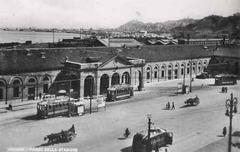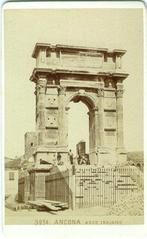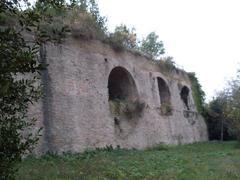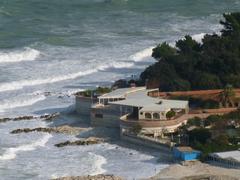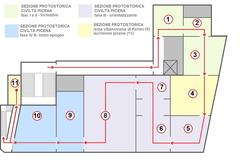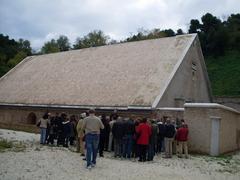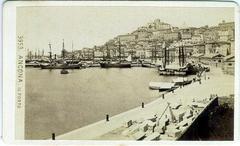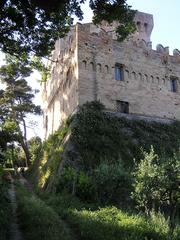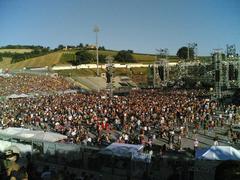
Santa Maria della Piazza: Visiting Hours, Tickets & Complete Guide to Ancona’s Historic Church
Date: 04/07/2025
Introduction
Santa Maria della Piazza is one of Ancona’s most treasured landmarks, offering a window into the city’s centuries-old religious, artistic, and civic traditions. Situated in the vibrant Porto district near the harbor, this Romanesque church is built atop even earlier Christian and pagan sites, making it a living testimony to Ancona’s layered history. Its striking marble façade, impressive archaeological remains—such as ancient mosaics visible beneath glass floors—and rich civic significance ensure that Santa Maria della Piazza is an essential destination for anyone interested in medieval architecture and Italian heritage. Recent restorations completed in 2024 have further enhanced visitor experience and preserved the church’s legacy for future generations (Ancona Tourism; Arcidiocesi di Ancona-Osimo; Triplyzer).
This guide provides detailed insights into Santa Maria della Piazza’s history, architectural highlights, visiting hours, ticketing, accessibility, nearby attractions, and travel tips—ensuring a rewarding and well-informed visit to one of Ancona’s most iconic historical sites.
Table of Contents
- Early Origins and Foundations
- Romanesque Construction and Medieval Evolution
- Architectural Transformations and Restorations
- Civic and Cultural Significance
- Artistic and Archaeological Highlights
- Visiting Hours, Tickets, and Accessibility
- Nearby Attractions and Photographic Spots
- Special Events and Community Role
- Visitor Tips and Practical Information
- Frequently Asked Questions (FAQ)
- Conclusion & Further Resources
Early Origins and Foundations
Santa Maria della Piazza stands on a site rich with religious and civic history. Archaeological evidence points to an original pagan temple, likely honoring a sea deity, reflecting Ancona’s maritime origins (renatoprosciutto.com). By the 4th century AD, it was home to a paleo-Christian basilica dedicated to Santo Stefano, considered Ancona’s first cathedral. Mosaics and fresco fragments from this era remain visible beneath the current church, preserved under glass for visitors to admire (anconatourism.it; wikipedia). These mosaics, with their geometric and symbolic motifs, offer rare insight into early Christianity in the region (corvinus.nl; italia.it).
Romanesque Construction and Medieval Evolution
The present Romanesque church was constructed between the late 11th and early 13th centuries, during a period of civic growth and maritime prosperity. Initially called Santa Maria del Canneto (“of the reeds”) after the marshy portlands, the church was later known as Santa Maria del Mercato (“of the market”) due to its location at the bustling city square (comuneancona.it; anconanostra.it). The rectangular plan, three naves separated by octagonal pillars, raised presbytery, and prominent apse are hallmarks of the Romanesque style. The marble façade, completed in 1210 by Master Filippo, features blind arches, sculpted reliefs, and decorative motifs that reflect both religious and civic symbolism (wikipedia; italia.it).
Architectural Transformations and Restorations
Throughout its history, Santa Maria della Piazza has undergone several significant modifications, often due to disaster or changing needs. In 1223, the apse was reconfigured and the naves extended. Fires and earthquakes, particularly in 1495 and 1690, led to reconstruction of the façade and bell tower—creating a visible contrast between original marble and later brickwork (italia.it; wikipedia). Restoration projects in the 20th and 21st centuries, including the 2024 campaign, have preserved both structure and archaeological remains for future generations (renatoprosciutto.com; Arcidiocesi di Ancona-Osimo).
Civic and Cultural Significance
Beyond its religious role, Santa Maria della Piazza has always been woven into Ancona’s civic life. The churchyard was the site of investiture ceremonies for the podestà (mayor), symbolizing the union of sacred and secular power (anconatourism.it). During the Napoleonic era, the church served as a stable and later an ammunition depot, only to be restored to religious use in 1806 (renatoprosciutto.com). Its survival through World War II bombings has furthered its reputation as a symbol of resilience (guidetoeurope.com).
Artistic and Archaeological Highlights
Inside, the raised presbytery features a 16th-century wooden crucifix and remnants of medieval frescoes. The crypt, accessible by stairs, preserves the mosaic floors of the earlier basilicas—some of the most significant early Christian remains in the Marche (corvinus.nl). The capitals display a variety of motifs, from foliage to zoomorphic figures, reflecting both Byzantine and Western influences (Triplyzer). The crypt’s archaeological layers, including paleo-Christian mosaics and medieval tombs, provide a tangible link to Ancona’s deep past.
Visiting Hours, Tickets, and Accessibility
- Hours: Tuesday–Sunday, 9:00 AM–6:00 PM; closed Mondays and public holidays.
- Admission: Free (donations welcome to support preservation).
- Guided Tours: Available by request, recommended for in-depth exploration; booking in advance is advised.
- Accessibility: Main areas are wheelchair accessible; crypt access requires stairs and may not be suitable for those with mobility issues (Arcidiocesi di Ancona-Osimo).
Nearby Attractions and Photographic Spots
Santa Maria della Piazza is perfectly situated for exploring other Ancona highlights. Within walking distance are the Ancona Cathedral, Lazzaretto (Mole Vanvitelliana), Piazza del Plebiscito, Porta Pia, and Trajan’s Arch. The lively piazza in front of the church offers excellent opportunities for architectural photography, especially of the ornate façade (Anita Villas).
Alt tag suggestions for images: “Santa Maria della Piazza Romanesque façade,” “Ancient mosaics under glass floor in Santa Maria della Piazza.”
Special Events and Community Role
The church regularly hosts concerts, cultural events, and exhibitions, particularly classical music performances that complement the church’s acoustics and aesthetic. As an active parish, it also serves for religious ceremonies and community gatherings. Check the Ancona tourism website or local listings for current schedules.
Visitor Tips and Practical Information
- Plan at least one hour to experience both the church and the crypt.
- Dress modestly, as the church is an active place of worship.
- Visit during off-peak hours (morning or late afternoon) for a quieter atmosphere.
- Combine your visit with nearby sites for a deeper exploration of Ancona’s heritage.
- Consider a guided tour for comprehensive historical and artistic context.
- Photography is generally allowed but be respectful during services.
Frequently Asked Questions (FAQ)
Q: What are the visiting hours?
A: Tuesday–Sunday, 9:00 AM–6:00 PM; closed Mondays and holidays.
Q: Is there an entrance fee?
A: No, but donations are appreciated.
Q: Are guided tours available?
A: Yes, by prior arrangement and often in multiple languages.
Q: Is the church wheelchair accessible?
A: Main areas are accessible; the crypt is not.
Q: What is the best time to visit?
A: Early mornings or late afternoons, especially in spring or autumn, offer a peaceful experience.
Q: What attractions are nearby?
A: Ancona Cathedral, Lazzaretto, Porta Pia, Trajan’s Arch, and the port district.
Conclusion & Further Resources
Santa Maria della Piazza is a vibrant symbol of Ancona’s spiritual and civic identity, seamlessly merging layers of history from ancient mosaics to medieval architecture. Its preservation and ongoing use as both a religious site and cultural venue make it a living monument. Take advantage of guided tours, explore the crypt, and combine your visit with nearby attractions for a fuller understanding of Ancona’s rich past and present.
For current visiting hours, guided tour bookings, and special events, visit the Ancona Tourism Portal or the Arcidiocesi di Ancona-Osimo.
Download the Audiala app for curated travel guides, offline maps, and exclusive content. Follow us on social media for updates and inspiration for your next Italian adventure.
References
- Santa Maria della Piazza in Ancona: Visiting Hours, Tickets, and Historical Significance, Renato Prosciutto
- Santa Maria della Piazza: Visiting Hours, Tickets, and Architectural Highlights in Ancona, Arcidiocesi di Ancona-Osimo
- Cultural and Religious Significance of Santa Maria della Piazza, My Italian Diaries
- Santa Maria della Piazza Visiting Hours, Tickets & Guide to Ancona’s Historic Church, Anita Villas
- Triplyzer: Things to Do in Ancona
- Wikipedia: Santa Maria della Piazza, Ancona
- Italia.it: Church of Santa Maria della Piazza, Ancona
- Comune di Ancona: Santa Maria della Piazza
- Ancona Tourism Official Site
Images optimized for SEO:
Internal links:
- Explore more about Ancona historical sites
- Plan your visit to Ancona Cathedral
- Download the Audiala app for travel guides


